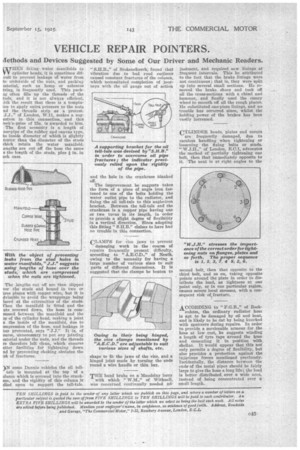VEHICLE REPAIR POINTERS.
Page 29

If you've noticed an error in this article please click here to report it so we can fix it.
4ethods and Devices Suggested by Some of Our Driver and Mechanic Readers.
WHNfitting water manifolds to E cylinder heads, it is sometimes difcult to prevent leakage of water from ae underside of the nuts, and packing taterial, such as hemp or asbestos tring, ie frequently used. This packag often fills up the threads of the tuds, and it is not always efficient, 7ith the result that there is a temptaion to epply extra pressure to the nuts nd the threads strip as a protest. J.J.." of London, W.11, makes a sagcation in this connection, and this reek's-prize of 15s. is awarded to him. The first necessity is a length of oser-pipe of the rubber and canvas type, he inside diameter of which is slightly rester than the diameter of the studs which retain the water manifold. ,engths are cut off the hose the same s the length of the studs, plus in. in ach ease.
The lengths cut off are then slipped ver the studs and bound in two or aree places with copper wire, but it is dvisahle to avoid the wrappings being laced at the extremities of the studs. Then the manifold is fitted and the uts screwed down, the hose is comressed between the manifold and the ep of the cylinder head, making a joint n the inside of the manifold, due to ()repression of the hose, and leakage is aus prevented, says " J.J." It is, of purse, unnecessary to put any jointing taterial under the nuts, and the threads re therefore left clean, which ensures etter facilities for tightening down ad by preventing choking obviates the sir of fractures.
)N some Dennis vehicles the oil telltale is mounted at the top of a olumn which is screwed into the crankace, and the rigidity of this column is ailed upon to support the tell-tale. " S.H.B.," of Stokenchurch, found that vibration due to bad road surfaces caused constant fractures of the column, which necessitated completion of journeys with the oil gauge out of action and the hole in the crankcase blanked off.
The improvement he suggests takes the form of a piece of angle iron fastened to one of the bolts holding the water outlet pipe to the radiator, and fixing the oil tell-tale to this angle-iron bracket. Between the tell-tale and the crankcase is a copper pipe having one or two turns in its length, in order to provide a slight degree of flexibility in a vertical direction. Sines adopting this fitting " &LLB." claims to have had no trouble in this connection.
CLAMPS for vice jaws to prevent
damaging work in the course of repairs frequently present difficulty, according to " A.E.C.D.," of Neath, owing to the necessity for having a large number of various sizes to suit parts of different dimensions. It is suggested that the clamps be beaten to
shape to fit the jaws of the vice, and a hinged joint made by turning the ends round a wire handle or thin bar.
THE hand brake on a Maudsley lorry with which " W.K," of Withnell, was concerned continually needed ad justinent, and required new linings at frequent intervals. This he attributed to the fact that the brake linings were not continuous ; that is, they were split up into several small sections. He removed the brake shoes and took off all the cross-sections with a chisel and hammer, and finally used the emery wheel to smooth off all the rough places. He substituted one-piece linings, and no trouble has occurred since, whilst the holding power of the brakes has been vastly increased.
CYLINDER heads, plates and covers are frequently damaged, due to careless handling when tightening or loosening the fixing bolts or studs. " W.J.H.," of London, E.C.1, advocates the method of partially tightening one bolt, then that immediately opposite to it. The next is at right angles to the second bolt, then that opposite to the third bolt, and so on, taking opposite points around the plate in order to distribute the load, as tightness at one point only, or in one particular region, causes severe local stresses, with a consequent risk of fracture.
ACCORDING to " of Beck
enham, the ordinary radiator hose is apt to be damaged by oil and heat, and is likely to be cut by being knocked with spanners during repairs. In order to. provide a serviceable armour for the hose at low cost, he suggests winding a length of tyre tape around the hose and cementing it in potation with shellac. It would appear that this not only permits a degree of flexibility, but also provides a protection against the injurious forces mentioned previously. Incidentally, the distance between the ends of the metal pipes should be fairly large to give the hose a long life ; the load is better distributed over a wide area, instead of being concentrated over a small length.






























